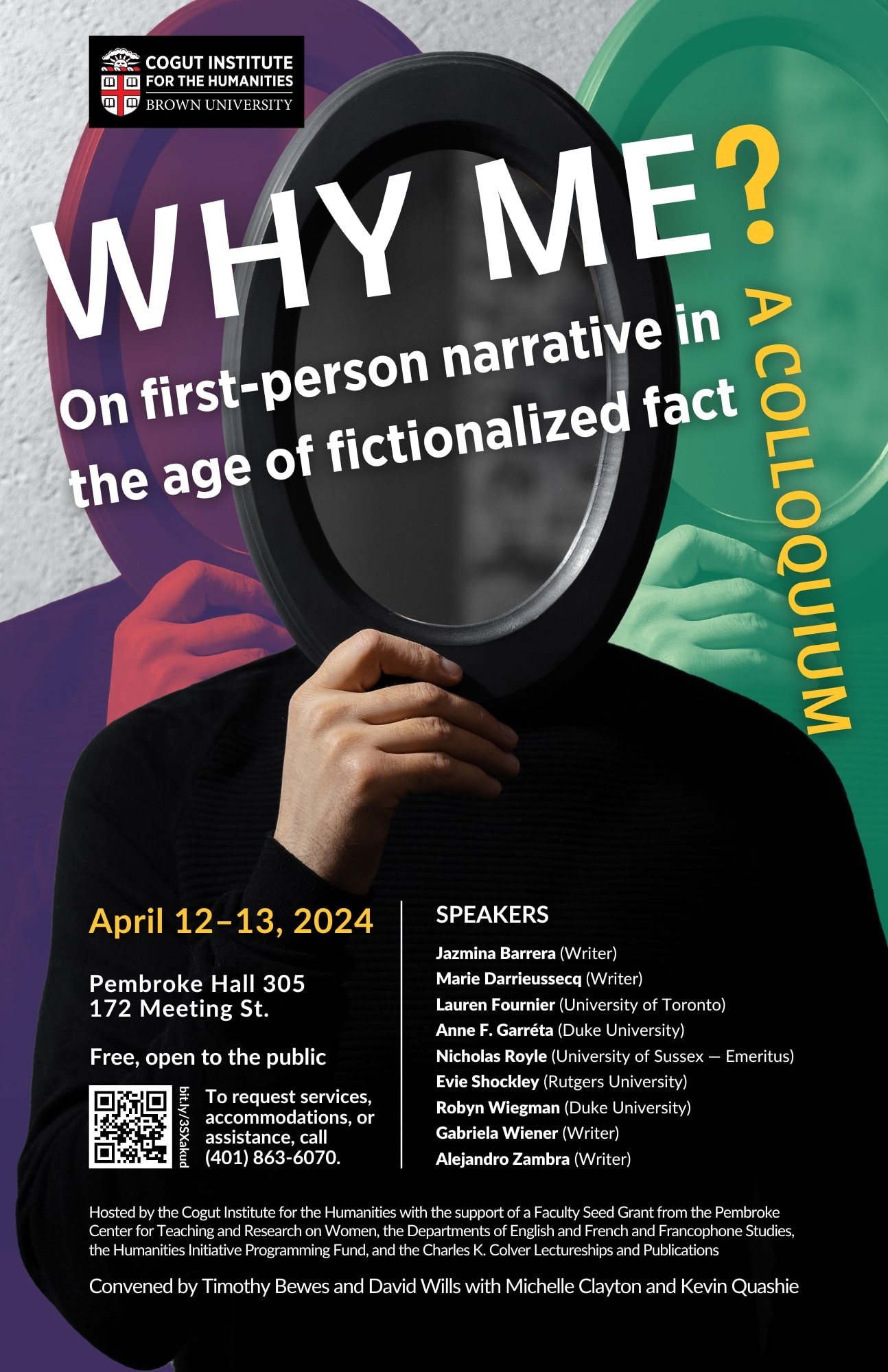Brown University Communications Projects
Year
2022—2023
Role
Designer, Project Manager
Brief
A selection of materials produced for the Cogut Institute for the Humanities at Brown University
Video Interviews
Measuring Impact with Qualitative Research
Interdisciplinary academic units such as the Cogut Institute for the Humanities work with departments across the university but have no dedicated students of their own, making it hard to track success in terms of figures such as graduation rates.
It’s important, therefore, to speak directly with people who have been involved with the institute as fellows, or instructors, or event conveners to to hear, in their own words, how the institute has benefited their learning, teaching, or research.
At the end of every academic year, I interview a different group of constituents. In 2023, I interviewed four outgoing postdoctoral research fellows whose two-year appointments at Brown had been funded by the institute, and I asked questions that would elicit responses about the breadth of their experience at Brown.
Questions
Describe the research project you completed as part of the fellowship.
How was your experience in the institute’s weekly seminar for fellows?
What’s something that you found especially memorable about the seminar?
How have your experiences at the institute impacted your research?
In what ways do you feel you’ve made an impact on the Brown community?
How has your fellowship prepared you for the next stage of your career?
Key Insights
The fellowship cultivates intellectual community across disciplines and ranks and alleviates the isolation of scholarly work
The fellowship provides scholars with the time and encouragement needed for experimenting with new ideas
The fellowship puts different disciplines into dialogue and thus highlights both shared interests and unique contributions
The fellowship provides postdocs with the opportunity to create and teach original course and involve students in their own research interests
The fellowship facilitates networking between postdocs and faculty members and leads to career-building opportunities
The fellowship prepares postdocs for a diverse working environment
The isolation of scholarly work can really weigh upon you a lot of the time. I think this is a place where you can come with ideas at any stage of development and say, “Is this anything? Does this make any sense to you?”
— Postdoctoral Fellow
Event Promotions
Organizing Information
Designing promotional materials for an event starts with a poster. Event posters in higher education often feature large quantities of text. It’s challenging not only to create a visually striking design when fitting lots of text onto a poster, but also to convey information hierarchy. Font choice, text size, color, and graphic elements such as speaker headshots and QR codes must be deployed thoughtfully.
Conveying Capacious Themes Visually
Events in higher education typically explore themes or subjects from multiple angles and in nuanced ways, in order to build dialogue among scholars. But how can a designer illustrate things that can’t easily be summarized?
In the Wake of War, a graduate student symposium, examined the aftermath of war through multiple disciplinary lenses. Of course, the subject brought to mind various concrete images that could be used on a poster, but most were unsuitable — they were too graphic or politically inflammatory or linked to a specific war.
I needed imagery without gore or recognizable landmarks, so I found a closeup of a destroyed wall, then applied various visual treatments, such as blurring and pixelation, to suggest the action of examining a site through multiple lenses.
The Collaborative Public Workshop, another symposium, had a very general theme: research produced through collaborative methods across disciplines. This suggested no particular concrete imagery at all.
So I unpacked the theme of the event to find possible imagery. I considered how interdisciplinary collaboration involved scholars bringing multiple research methods to bear on a shared subject, influencing each other in the process.
With this in mind, I developed abstract imagery of overlapping maps and orbiting planets.
Drafting and Iterating
In designing a poster, I develop multiple rough drafts and then share a selection with key stakeholders (generally the faculty members organizing the event) to choose a favorite or to suggest an alternative design direction.
My early poster concepts for the colloquium Why Me involved individuals holding or looking into mirrors. The stakeholders, however, wanted to avoid indicators of gender or race, so I went back to the drawing board.
But I wasn’t starting entirely from scratch. Sharing drafts for feedback allowed me to identify various elements that resonated with the stakeholders. For example, the stakeholders liked the imagery of mirrors, just not of people, and they preferred horizontal text to angled.
Accounting for the stakeholders’ preferences helped me quickly to produce a final design that satisfied everyone and stay on schedule for publicizing the event.
Iterating and Experimenting Over Time
Given that I publicize dozens of events every semester, there’s rarely time to share multiple rounds of drafts for any one poster project. But in working on posters over time, I can refine and experiment with visual treatments, the placement of elements, information hierarchy, etc. This is especially true of posters for events in a recurring series, where I work with the same stakeholders again and again.
Adapting Designs Across Platforms
Once the poster design for an event is approved, I translate the design into a host of digital materials, including e-invitations, social media image cards, and video title cards, each of which has unique technical specifications and user expectations.
Poster
E-invitation
Social Media Image Card
Video Title Card


















